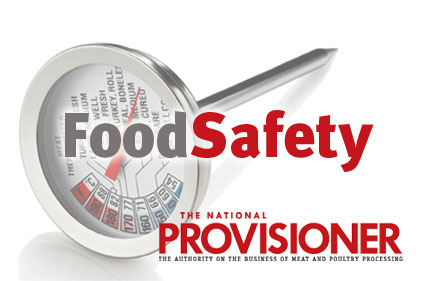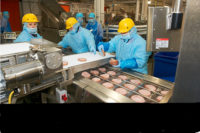The National Provisioner sat down in January with Dr. Dan Hale, professor in Texas A&M University’s Department of Animal Science and with the Texas A&M AgriLife Extension Service, to discuss traceability and its slow introduction into the beef production system. What follows is the conversation between Hale and Andy Hanacek, editor-in-chief of The National Provisioner.
What are some of the trends you’re seeing out in the industry regarding traceability? And how is it different now maybe than it was a year or two ago?
Hale: As far as the beef industry goes with respect to traceability, you have really two different streams of consumption [that production aims to serve]. No. 1, which is really, by far and away, the largest group, is to produce beef for the general consumer, for whom maybe traceability is not on their mind. Really, what’s on their mind is being able to provide a meal that evening.
On the other side, there’s No. 2: small, small pockets of consumers — I’ve seen estimates from anywhere from one to maybe four percent — who want traceability from the standpoint of locally owned or being able to trace their food back to the land — natural, grass-fed, those types of beef products.
What I’m seeing is, more of the larger processors produce the first stream in large quantities, but they also are looking at being able to provide a product in that other stream as well. For example, the two major retail grocery stores in this town [College Station, Texas,] both offer a product that you can trace back through to a Texas facility. That’s something you wouldn’t have seen at least two years ago.
Those products are whole-muscle products?
Hale: Yes, whole-muscle products. Generally, what you see them sell is one ground-beef product and then one or two different kinds of steaks. They don’t do the whole animal, that’s for sure, because they really don’t have that kind of demand. … In the full-service case, they’re offering different kinds of products, and that’s where you’ll find the grass-fed or natural or organically raised beef, and the Texas-homegrown products. They’ll sell maybe three or four different cuts in that case for that particular brand.
What type of premium are they getting for these homegrown beef products?
Hale: You’ll see $5.00 to maybe $10.00 per pound premium for some of these products, with organic product being probably getting the highest premium. But the local Texas product is probably not quite that much.
With beef, do you think it’s worth the premium that markets charge? Do you think consumers are truly getting a value for that premium when they buy local like that?
Hale: As a meat specialist, if I looked at the question: Why do we eat beef? Well, we eat beef because it tastes good, because it’s a good protein source, and because it’s healthy and safe. I would tell you every single beef product, in my mind, so long as it has passed USDA and gone through the general beef production system, there’s no difference in any of that beef from a safety standpoint.
I work specifically with humane handling, and I will tell you that every plant that I worked with has a very comprehensive animal-handling process, so I don’t believe there’s any difference in the humaneness of how the animals are handled between the different systems. So I don’t necessarily think that there’s any real difference — but I know that there’s a perceived difference, and when there’s a perceived difference in the minds of certain consumers, then it’s real to them.
And if it’s real to them and they’ll pay more for that product, then producers will end up figuring ways to meet that consumer need. … So I’m all for producing those kinds of products, but I kind of cringe when people use food-safety trends and say, “Well, this [premium product] is a more safe product with better humane handling than this product, because it was produced in a larger production system. The facts don’t really bear that out at all.
It’s just not an issue. Food safety between large and small processors or the larger production stream versus a smaller production stream, produces healthy, safe products, and I think they’re both very viable products for the customer.
What is your take on how the producers themselves have taken to traceability in general?
Hale: I am finding that there are both larger processors as well as smaller processors taking advantage of a market that wants more locally raised and more traceable product. So let me give you two examples.
One example is a small producer with only 50 cattle a year. Instead of selling individual cuts, they’ll sell a carcass or a large beef animal to a person, and then they’ll work with them to get it processed. And so there’s one method of traceability on a very small scale that’s doable for a small producer.
The second example is a large producer with larger feed yards. Within that feed yard, you’re going to see the general production system for the masses of beef that needs to be produced to meet the general consumer’s needs.
But they also will have a pen here and there or a specific feed yard or a specific program that’s geared toward a retailer who wants a certain kind of beef product, or a retailer who says, “In addition to selling whatever I normally sell in the self-service case, I want to be able to compete with another beef seller for a traceable, high-quality beef product.”
So that large producer will be feeding a few pens of cattle for that specific retailer. So more are looking at how to meet that other need, and trying to fit the economy of scale that’s required.
What are some of the constraints or obstacles these producers are running into when trying to address that demand for traceable product?
Hale: Just the number of cattle that are available is a constraint. There are a lot of people competing for these cattle, and you may find people paying as much for the cattle to be able to sell steaks and roasts and ground beef to their normal consumers, as those that want this niche market have. Cattle are selling for $140 per hundredweight [at presstime]. Because of the supply shortage, it may actually slow down some of the special niche markets, because you’re getting a pretty high price for just the more normal production stream. If you’re focusing on that niche, it’s going to be a constraint because you’re going to have more people trying to buy the same animal you want.
Despite the fact that it is a niche, the availability of traceable beef products has improved of the years?
Hale: I think one interesting fact we found in the National Beef Quality Audit shows that at least we have more of the technology in place to do trace-back. In the audit, we looked at cattle as they were coming into the packing plant, and we looked at different types of identification. In 2005, 3.5% of the cattle had an electronic ear tag, and 20.1% of the cattle had an electronic ear tag in 2011.
To me, that says there are people at least collecting more data. Maybe the data only go back to the feed yard, maybe not all the way back to the rancher. But generally when you have an electronic ear tag, it means that they’re probably geared toward source- and age-verified or some sort of branded beef program.
Have you seen any worthwhile growth, then, in the adoption of branded beef programs instituted at the producer/processor level?
Hale: In 1995, when we first did the National Beef Quality Audit, the average number of branded beef programs at a packing plant was 1.3; in 2005, it was 5.3; and in 2011, the average number of branded beef programs per packing plant was 6.4. So there’s a trend upward — in 15 years we’ve gone from 1.3 to 6.4 per packing plant.
And, in fact, most of the large feeders now do have readers, and then also packing plants have readers for the electronic ear tags. So that’s again another technology that has helped us be do that trace-back.
Where do you see the trend in traceability heading? There are a lot of factors pushing on traceability, which you just alluded to in terms of the market factors, the production, the size of production, the cattle in production, things like that.
Hale: You’ll still continue to see an increase in the industry. I think there’s one reason you might see an additional increase than what you’ve seen in the past, and that’s because of the goals to improve the efficiency of production. So, if I am able to trace animals through my system, and I’m using genetic tools and the technology now, then it is to my benefit to be able to trace certain animals through the production system. Not just because people want to see how the animal was raised, but also to see the genetics and feed efficiency, increase yield and efficiency of the animals. My definition of sustainability is, producing more pounds of beef with fewer resources. And if you can be more efficient in production while doing that, then traceability will be a tool that can help do that.



Report Abusive Comment